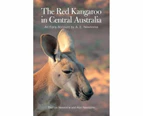The Red Kangaroo in Central Australia : An Early Account by A.E. Newsome

The Red Kangaroo in Central Australia : An Early Account by A.E. Newsome
ISBN: 9781486301553
Publication Date: 1 July 2016
The red kangaroo is at the heart of Australia's ecological identity. It is Australia's largest terrestrial land mammal, the largest extant marsupial, and the only kangaroo truly restricted to Australia's arid interior. Almost nothing was known about the ecology of the red kangaroo when a young Alan Newsome began to study it in 1957. He discovered how droughts affect reproduction, why red kangaroos favor different habitats during droughts from those after rains, and that unprecedented explosions in red kangaroo numbers were caused by changes to the landscape wrought by graziers. Most importantly, he realized the possibilities of enriching western science with Indigenous knowledge, a feat recognized today as one of the greatest achievements of his career.
First drafted in 1975 and now revised and prepared for publication by his son, The Red Kangaroo in Central Australia captures Alan's thoughts as a young ecologist working in Central Australia in the 1950s and 1960s. It will inspire a new generation of scientists to explore Australia's vast interior and study the extraordinary adaptations of its endemic mammals. It will also appeal to readers of other classics of Australian natural history, such as Francis Ratcliffe's Flying Fox and Drifting Sand and Harry Frith's The Mallee Fowl, The Bird that Builds an Incubator.
Features:
* Provides an in-depth look at one of Australia's most iconic land mammals and the wonder of red kangaroo biology
* Details working life in Central Australia during the 1950s and 1960s along with the unique link that Alan established with Australia's Indigenous Aranda people
* A rare insight into the experience of scientific discovery, especially in the unforgiving environment of Central Australia
‘Don’t Pay’ is the recommended retail price provided by the supplier or obtained from the manufacturer, or is the recently advertised price for the same product on a different or competing online platform or store. Catch may not have previously sold the product at the ‘Don’t Pay’ price.
